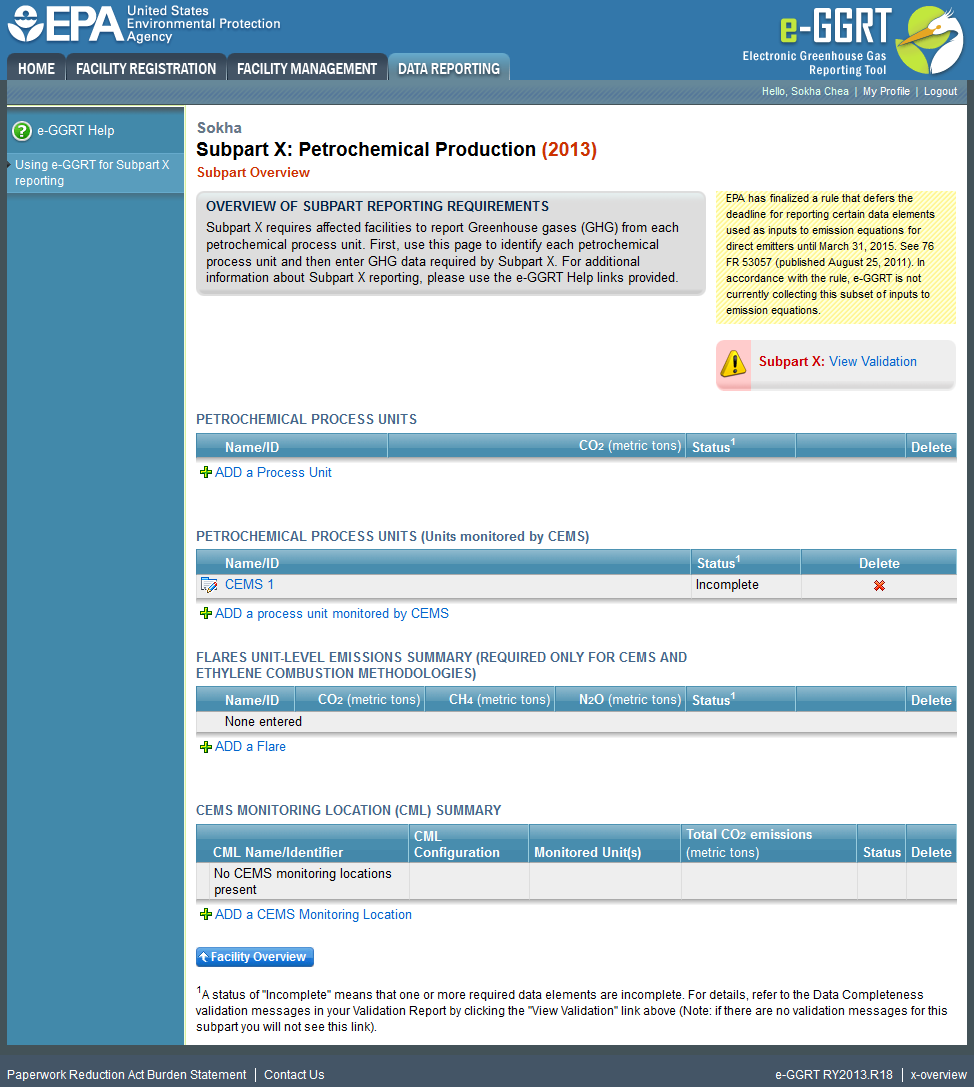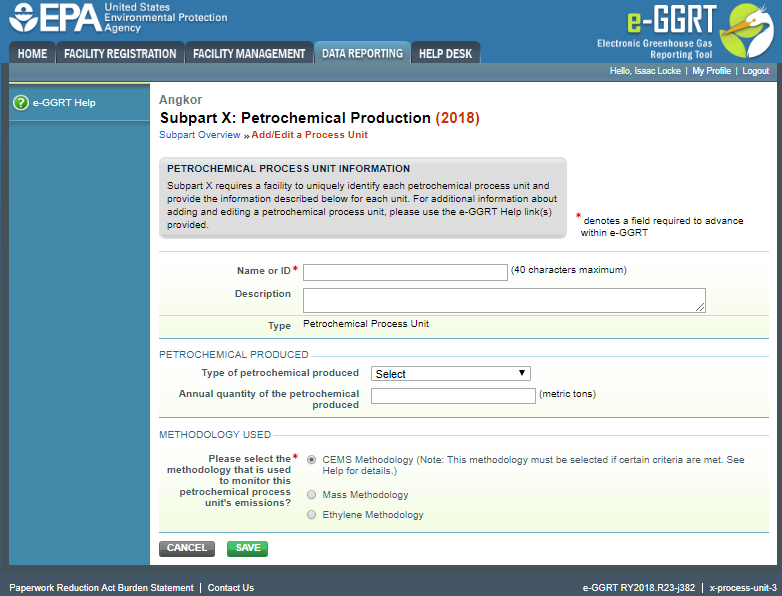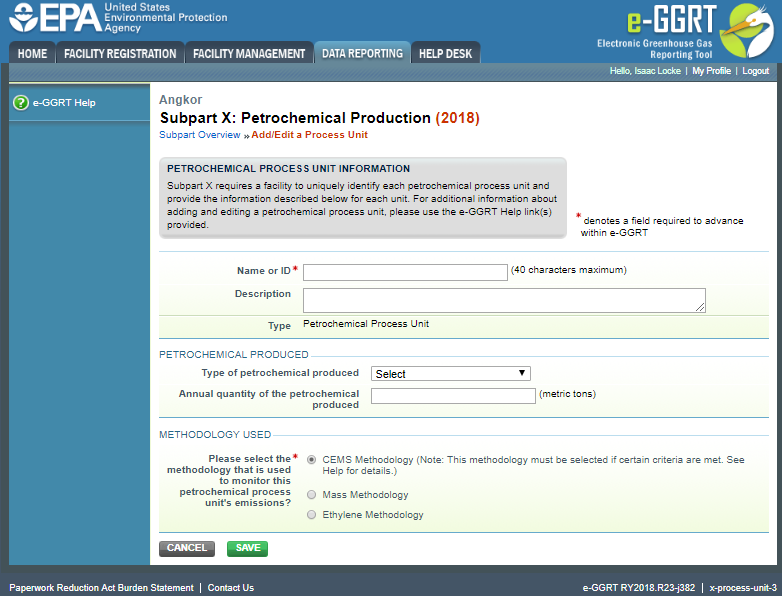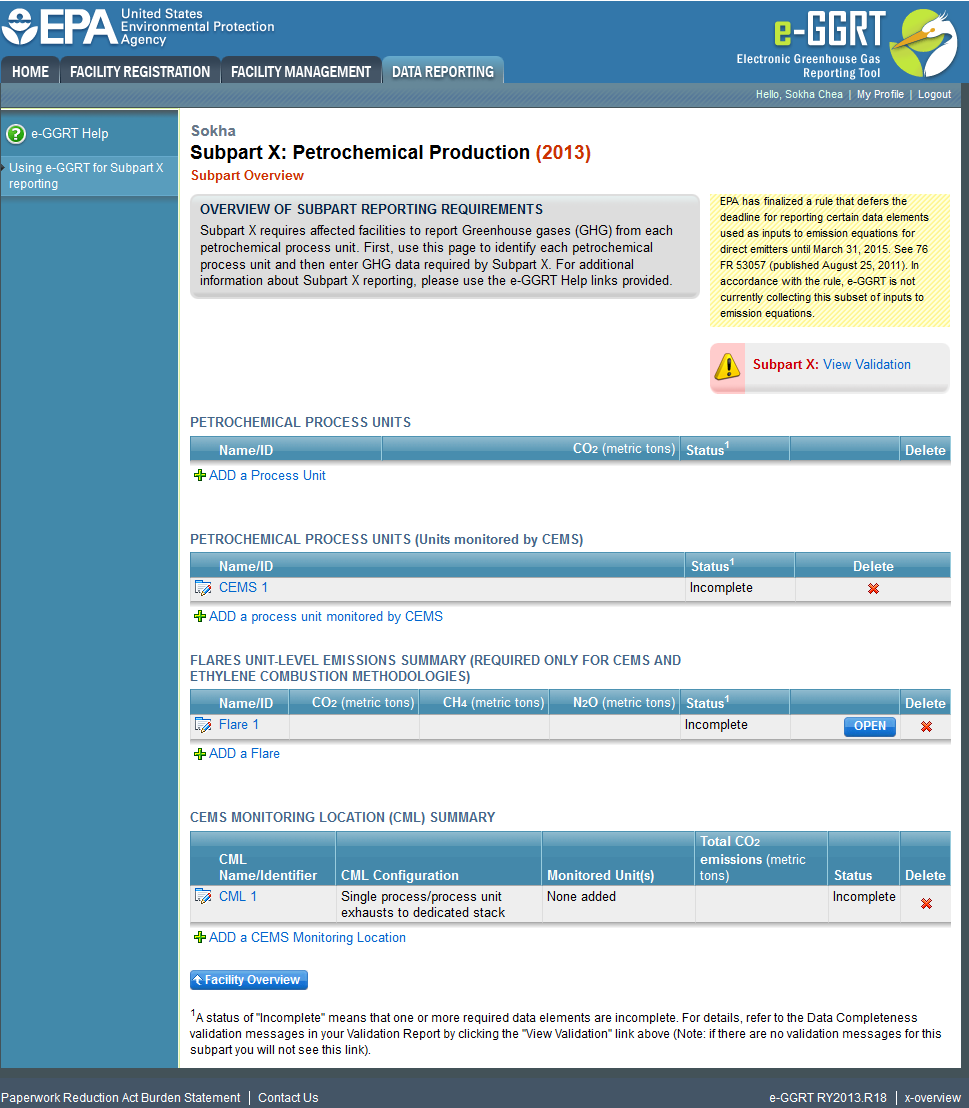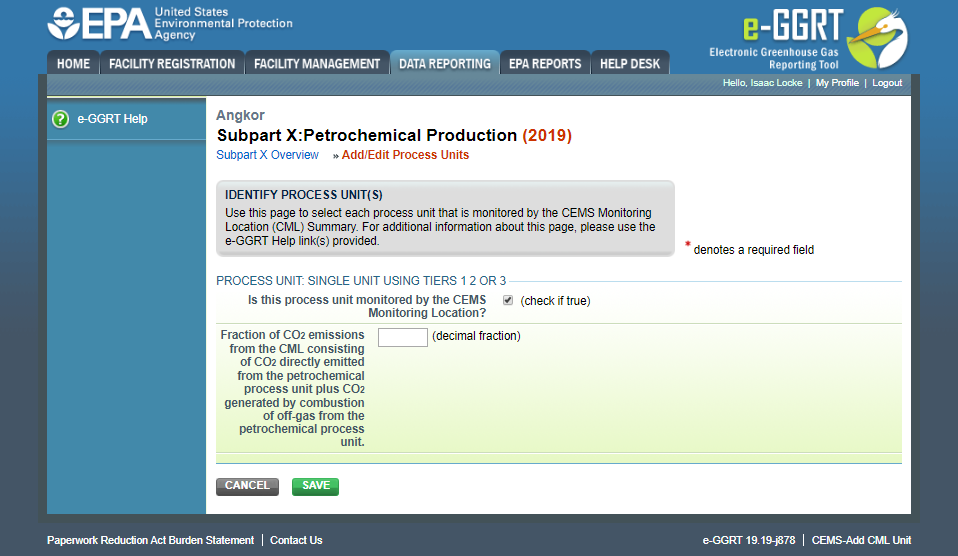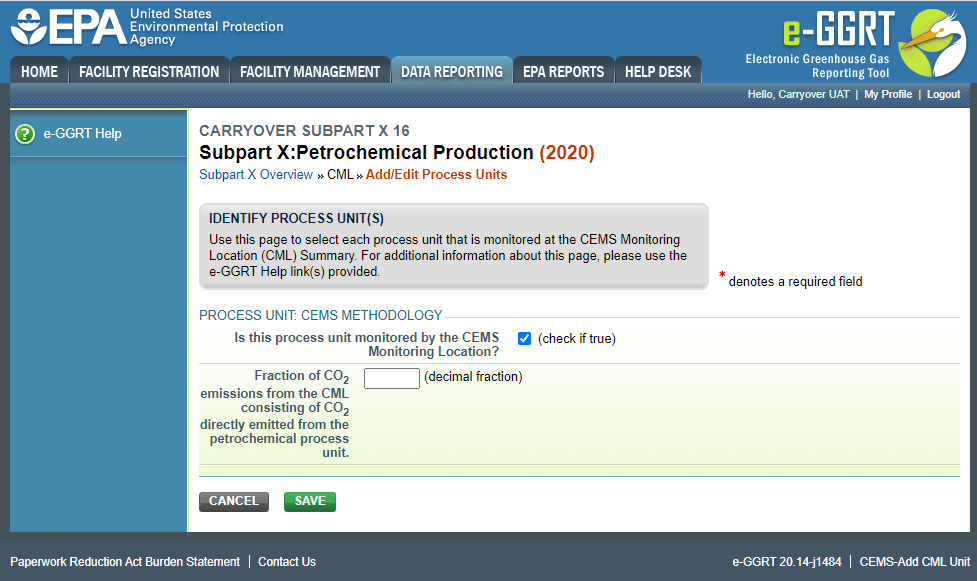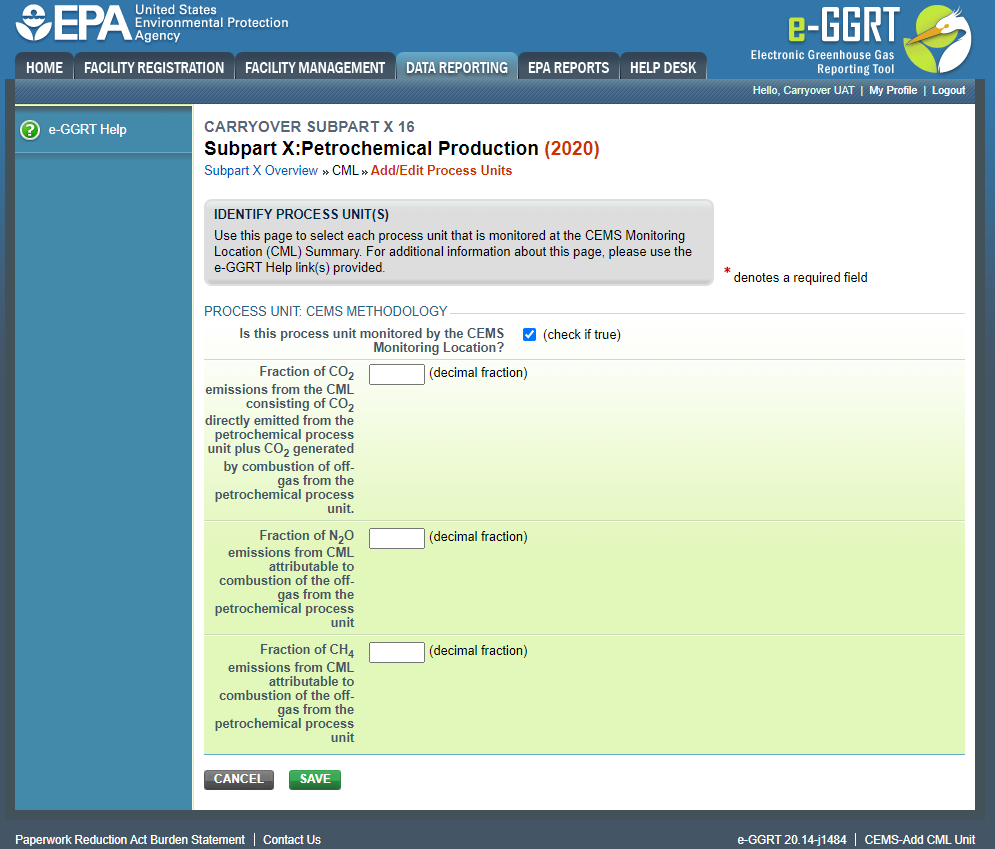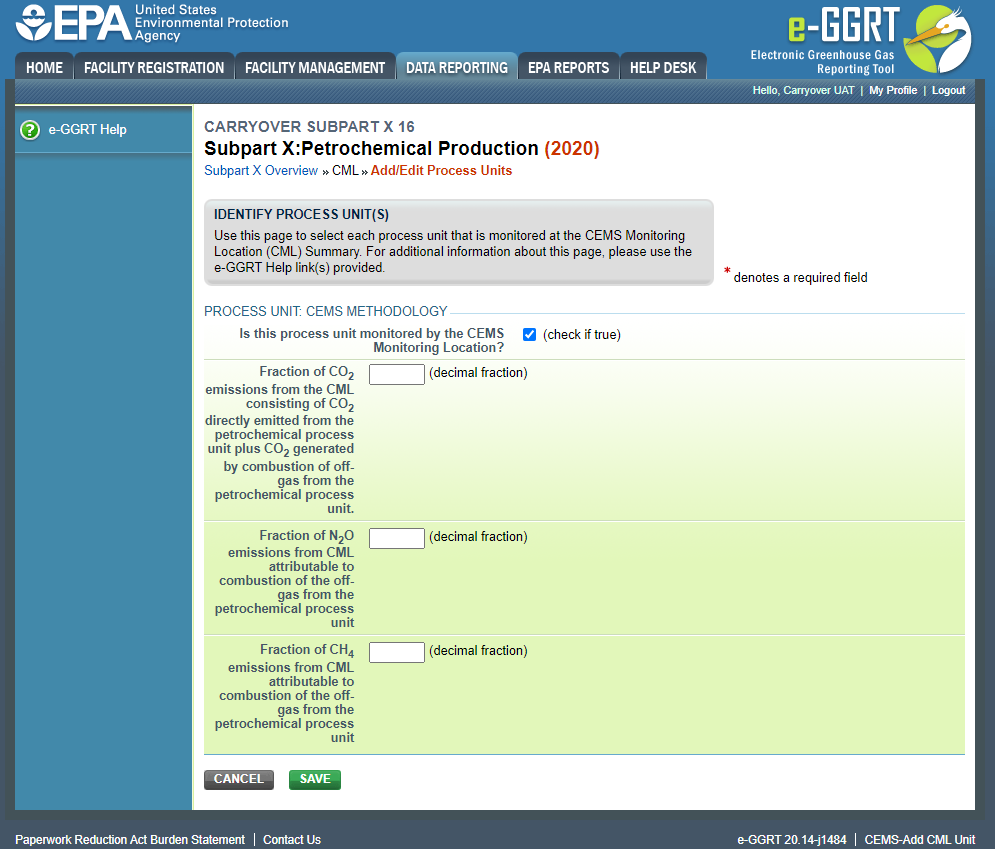This help page provides a step-by-step description of how to enter information related to the CEMS reporting methodology for a petrochemical process unit.
Step 1. Adding Process Unit that is Monitored by CEMS
Start on the Subpart X Overview screen and click on either the "+Add a Process Unit" link or the "+ADD a process unit monitored by CEMS" link. This action takes you to the "x-process-unit-1" screen. Select "CEMS Methodology" and NEXT. This action takes you to the "x-process-unit-3" screen. Enter information about the process unit as described in the (Process Unit Summary Information section) of these help instructions.
The two screenshots below present examples of how the "x-overview" and "x-process-unit-3" screens could look after entering information for one process unit.
Click this link to expand
Click this link to expand
Step 2. Adding Flares and a CEMS Monitoring Location
Click this link to expand
When the CEMS methodology option is selected for a process unit, two additional tables are added on the “x-overview” screen.
One table is titled “Flares Unit-Level Emissions Summary (Required Only for CEMS and Ethylene Combustion Methodologies)”. Click on the “ADD a Flare” link below the table to add information about any flare that controls emissions from a petrochemical process for which you are estimating emissions using the CEMS Methodology. See the Subpart Y Flare Reporting Help for details on the information to report for flares.
The second table added on the “x-overview” page is titled “CEMS Monitoring Location Summary”. You must add at least one CEMS Monitoring Location (CML) when you have process units(s) that are monitored by a CEMS. To add a CML, click on the “ADD a CEMS Monitoring Location” link. This action takes you to the “CEMS-Add CML” screen. Additional details on the information to add on this screen are provided below.
Step 3. Adding data for a CML
Click this link to expand
Subpart X requires you to provide the following information for each CML:
- A unique name or identifier for the CML (see also About Unique Names). You may also provide an optional description of the CML to supplement the name or identifier.
- One of the following CML Configuration Types
- Single process/process unit exhausts to dedicated stack. Select this configuration when a CO2 CEMS is used to measure a vented stream from a petrochemical process unit, and the stream is not combined with emissions from other processes or combustion units before the CEMS. Also select this option when a CO2 CEMS measures the outlet stream from a non-combustion control device that is used to control process vent emissions from a petrochemical process, and the outlet stream from the control device is not combined with emissions from other process units or combustion devices before the CEMS.
- Multiple processes/process units share common stack. Select this configuration only if multiple petrochemical process units share a stack for process vent emissions, or a petrochemical process unit and other types of process units share a stack for process vent emissions, and the shared stack contains no combustion unit emissions. If multiple petrochemical process units, or a petrochemical process unit and other types of process units, share a stack with one or more combustion units, then select the configuration below.
- Process/stationary combustion units share common stack. Select this configuration anytime petrochemical process off-gas is routed to a combustion unit. Also select this configuration when exhaust from combustion units burning any fuel other than the petrochemical process off-gas is routed to the same stack as process vent emissions from the petrochemical process unit.
- Types of fuel combusted in the unit(s) monitored by the CEMS. This data entry box is only available with the "Process/stationary combustion units share a common stack" configuration type.
- Calculation Methodology Start Date and End Date
Subpart X also collects the following additional information about a CML:
- Quarterly CO2 Emissions measured by the CEMS
- Quarter 1 (metric tons)
- Quarter 2 (metric tons)
- Quarter 3 (metric tons)
- Quarter 4 (metric tons)
Total Annual CO2 Mass Emissions (biogenic and non-biogenic) Measured by the CEMS (metric tons). Note that the value reported here should in most cases equal the sum of the 4 quarterly values reported above and the sum of the biogenic and non-biogenic emissions reported in the next two cells. The exception is when there was a slipstream that bypassed the CEMS. In these cases, the slipstream emissions should be added to this total, but, should not be included with the either the quarterly values or the total annual non-biogenic emissions.
- If there was a slipstream that bypassed the CEMS
- Total Annual Biogenic CO2 Mass Emissions for the CML (metric tons)
- Total Annual Non-Biogenic CO2 Mass Emissions (includes fossil fuel, sorbent, and process CO2 emissions) for the CML (metric tons)
- Total Annual CH4 Emissions (metric tons) – Use Equation C-10 to calculate.This data entry box is only available with the "Process/stationary combustion nits share a common stack" configuration type. If multiple fuels are burned in a combustion unit, then the value to report here is the sum of the calculated values over all of the fuels.
- Total Annual N2O Emissions (metric tons) – Use Equation C-10 to calculate. This data entry box is only available with the "Process/stationary combustion nits share a common stack" configuration type. If multiple fuels are burned in a combustion unit, then the value to report here is the sum of the calculated values over all of the fuels.
- Total number of source operating hours in the reporting year (hours)
- The total operating hours in which a substitute data value was used in the emissions calculations for CO2 concentration (hours)
- The total operating hours in which a substitute data value was used in the emissions calculations for stack gas flow rate (hours)
- The total operating hours in which a substitute data value was used in the emissions calculations for stack gas moisture content (if moisture correction is required and a continuous moisture monitor is used) (hours)
CEMS monitoring location process units. Below the CEMS Monitoring Location Process Units table on the “CEMS-Add CML” screen, click on the “ADD/REMOVE/EDIT a Process Unit” link. This action will take you to the “CEMS-Add CML Unit” screen, which lists all of the petrochemical process units monitored by a CEMS that you have already entered into eGGRT. Click on the check box next to each process unit that routes process emissions (defined as both CO2 emissions generated in the petrochemical process and GHG emissions generated by combustion of off-gas from that process) to the identified CML.
Depending on both the configuration type selected on the Add/Edit CEMS Monitoring Location page and the reporting year, different data entry fields will be displayed after clicking a check box.
- For RY 2019, if the configuration type is set to, "Single process unit exhausts to dedicated stack" and the unit is monitored at the CEMS monitoring location, the Add/Edit Process Units page will ask for the
- Fraction of CO2 emissions from the CML consisting of CO2 directly emitted from the petrochemical process unit plus CO2 generated by combustion of off-gas from the petrochemical process unit."
click this link to expand
- For RY 2019, if the configuration type is set to, "Multiple processes/process units share common stack" and the unit is monitored by the CEMS monitoring location, the Add/Edit Process Units page will ask for the:
- "Fraction of CO2 emissions from the CML consisting of CO2 directly emitted from the petrochemical process unit plus CO2 generated by combustion of off-gas from the petrochemical process unit."
click this link to expand
- If the configuration type is set to, "Process/stationary combustion units share common stack" then the Add/Edit Process Units page will ask for the:
- "Fraction of CO2 emissions from the CML consisting of CO2 directly emitted from the petrochemical process unit plus CO2 generated by combustion of off-gas from the petrochemical process unit."
- "Fraction of N2O emissions from CML attributable to combustion of the off-gas from the petrochemical process unit."
- "Fraction of CH4 emissions from CML attributable to combustion of the off-gas from the petrochemical process unit."
click this link to expand
Repeat the steps in this section for each additional CML that is associated with the petrochemical process unit.
Step 4. Modifying data for a CML
Click this link to expand
To modify information related to a particular CML, locate the CEMS Monitoring Location Summary table on the “Subpart Overview” screen and click on the desired Name or ID in the left-most column in the table.
Step 5. Deleting a CML
To delete an existing CML, locate the applicable CML name or ID in the CEMS Monitoring Location (CML) Summary table on the “x-overview” screen and click the red “X” icon in the Delete column for that CML.
See Also
Screen Errors
Using e-GGRT to Prepare Your Subpart X Report for RY2014 and Later
Subpart X Process Unit Summary Information for All Reporting Years
Subpart X MASS BALANCE Option Reporting for RY2014 and Later
Subpart X Entering MASS BALANCE Equation Inputs Using IVT
Subpart X ETHYLENE Option Reporting for All Reporting Years
Subpart X CEMS Option Reporting for All Reporting Years
Subpart X IVT Equation Inputs Summary
Subpart Validation Report


